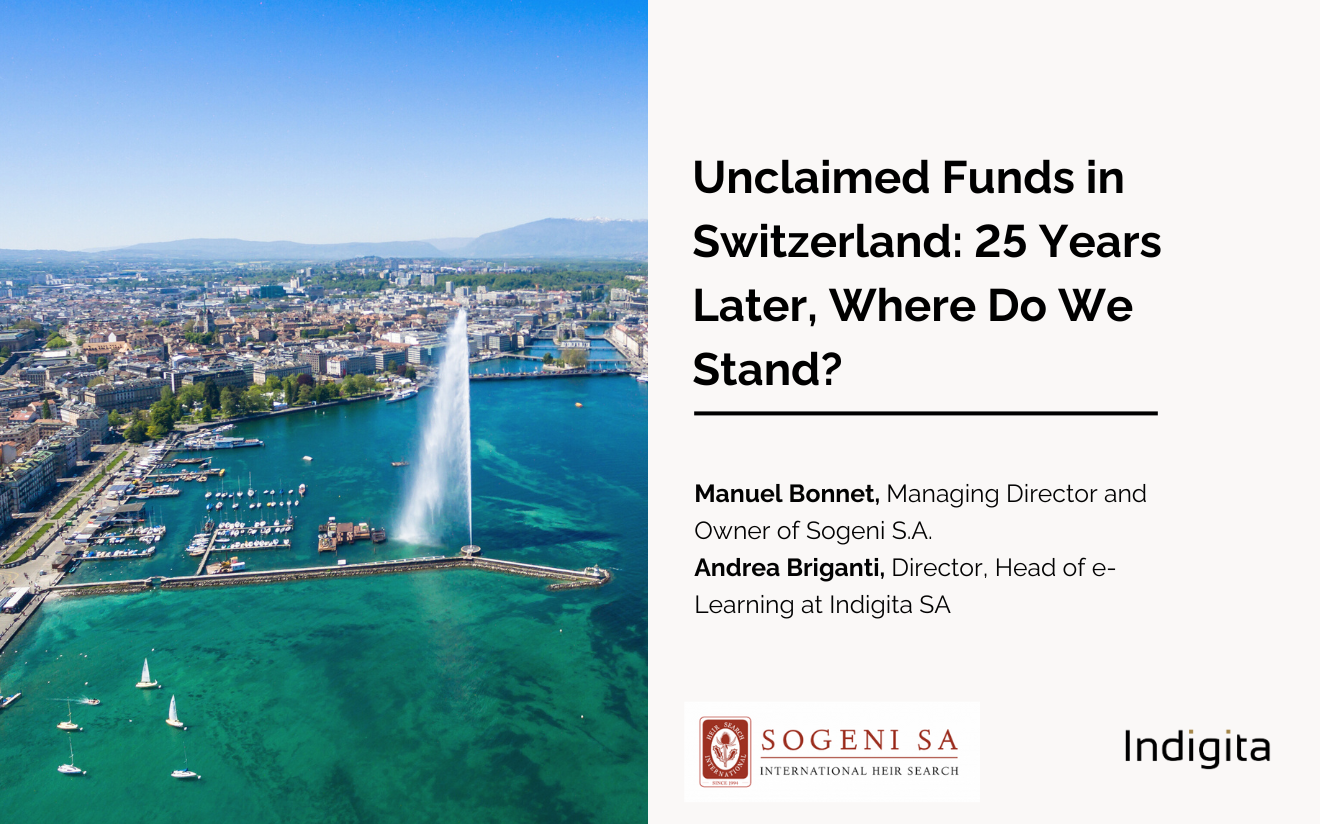Authored by Manuel Bonnet, Managing Director and Owner of Sogeni S.A. and Andrea Briganti, Director, Head of e-Learning at Indigita SA.
At the end of the 1990s, the issue of unclaimed funds in Switzerland placed the Confederation under the global spotlight. Accused of opacity and negligence, Swiss banking institutions came under significant public pressure. So, what has the legislature done, and how have practices evolved over the past 25 years?
The Regulatory Framework
The regulation implemented since the 2000s granted significant autonomy to banking authorities to standardize and govern practices.
Thus, the Swiss Bankers Association (SBA) established an initial set of guidelines in 2004, which underwent major revision on January 1, 2015, to include the terms of publication and liquidation of unclaimed assets. This set of guidelines, commonly known as the Narilo Guidelines, outlines numerous procedures and practices that Swiss banks must follow in managing dormant and unclaimed assets. The latest revision came into effect on January 1, 2022.
The Swiss Parliament, for its part, laid out several general principles in law, effective January 1, 2015:
- Article 37m of the Banking Act (BA) mandates the publication of assets after 50 years of being unclaimed, for a duration of one year. If no claim is made within that time, the funds are transferred to the Confederation.
- Articles 45 to 59 of the Banking Ordinance (BO) detail the criteria and procedures for formalizing the status of unclaimed assets and their handling.
Managing Unclaimed Assets: Harmonization of Practices in the Banking Sector
When properly known and applied, the Narilo Guidelines address many of the issues that arise with dormant or unclaimed assets.
Identification of Dormant Assets
Loss of contact with the client is a key trigger. An asset is officially considered unclaimed after 10 years of inactivity.
Administration of Assets
Recommendations are aimed at safeguarding client rights:
- Suspension of authorizations and management by a dedicated unit
- Active search for the client, possibly with help from specialized service providers
- Prudent management of assets according to the client’s mandate
- Registration on the central platform managed by the Swiss Banking Ombudsman
- Publication of assets after 50 years of inactivity, followed by liquidation in favor of the Confederation if no claim is made within one year.
Despite the detailed regulatory framework since 2015, actual practices may vary depending on the level of expertise and resources within individual institutions. It’s crucial for these institutions to train relevant teams to ensure compliance and best protect beneficiaries’ interests. Specialized companies can greatly assist in finding account holders and beneficiaries—something some institutions may not be aware of.
The Key Role of Private Bankers: Best Practices to Adopt
When a private banker detects a dormant account, their role becomes essential. They must reestablish contact while strictly adhering to the correct procedures.
Proactive Engagement
- Maintain regular contact with clients through periodic reviews and follow-ups (meetings, calls).
- Encourage clients to update their contact information and beneficiary details regularly.
- Proactively inform clients about the risks and implications of account inactivity.
Thorough Documentation
- Record all communication attempts (calls, emails, letters) with dates and times.
- Keep clear records of client preferences and instructions.
- Document any investigations in case of audits.
Risk-Based Monitoring
- Use internal systems to detect early signs of inactivity (e.g., after 2–3 years).
- Implement alerts or triggers for accounts nearing dormancy.
- Prioritize high-value or high-risk accounts for immediate action.
- Use CRM systems and online banking platforms to monitor interaction history.
- Encourage clients to regularly log in to digital platforms as a point of contact.
- Collaborate with other departments (legal, compliance) in case of suspected dormancy.
- Share observations and trends with colleagues to optimize the collective response.
From this perspective, employee training remains a key tool in preventing dormancy. A good understanding of legal and internal obligations enables effective anticipation.
How Does Switzerland Compare to Its Neighbors?
A brief overview of unclaimed asset regulations shows that Switzerland’s framework is generally more comprehensive and protective for account holders and their heirs.
- In France, banks have no obligation to search for account holders, unlike in Switzerland or Luxembourg.
- Neither France nor Luxembourg publishes unclaimed assets; they simply have a portal for presumed heirs.
- In Germany and Austria, the law favors credit institutions—they have no obligation to search for heirs, and after 30 years, they can appropriate the assets.
Conclusion: A Model Framework to Be Strengthened
Since the scandal of the 1990s, Switzerland has responded with a structured and protective regulatory framework. Thanks to the Narilo Guidelines, banking practices have become largely harmonized, providing a high level of security for account holders or their heirs.
Compared to other European jurisdictions, the Swiss model remains one of the most favorable for beneficiaries. However, ongoing awareness among banking professionals and staff training are essential to maintain this high standard.




